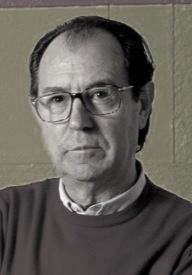Rafael Canogar
A disciple of Daniel Vázquez Díaz (1948-1953), in his early works he found a way to reach the avant-garde and, very soon, to study abstraction in depth.
He initially used a sculptural-pictorial technique: with his hands he scratched or squeezed the paste which he made vibrate on a background of flat colours. It was a painting in which the initial gesture came directly from the heart. At this point Canogar embodied the best of matter painting.
In 1957, together with other artists (A. Saura, M. Millares, Luis Feito and Pablo Serrano) and the critic José Ayllón, he founded the Madrid group El Paso. He was influenced by Action painting. Between 1957 and 1960 they defended an informal aesthetic and the opening up of Franco’s Spain to the international scene.
Informalism was eminently the expression of freedom, of the unrepeatable and unique, carried out with a direct and spontaneous calligraphy.
These were eminently intuitive and passionate works, executed with the urgency that time, age and theories demanded. Informalism was for Canogar something substantial and mystical, self-affirmation and self-realisation. But this radical position could not, according to Canogar, be maintained indefinitely without becoming “academic” and insufficient to communicate and express the tension of reality, of the new social and political awareness that was awakening in the world.
The third dimension finally gave a solution to the new work, to his second period which, from 1963 onwards, gradually returned to the reality of an increasingly narrative complex figuration. The incorporation of new materials allowed him to project them into the viewer’s reality, with explicit reference to and an inescapable attempt to make the viewer participate in a collective drama. The critic Vicente Aguilera Cerní wrote about Canogar’s works: “The themes do not express opinions, they reflect facts, but the facts are human dramas, they are reified images where the human, object and quantity, acquire symbolic hierarchy….”. In 1974 he took part with Wolf Vostell, Edward Kienholz and other artists in Berlin in the activities of ADA – Aktionen der Avantgarde. In 1975 he abandoned realism and for a period produced eminently abstract works, an analysis of painting, of the support, of the two-dimensionality of painting. But Canogar needed to invent a new iconography, to recover the memory and – in a tribute to the historical avant-garde – he did this through the mask, the head, the face, as a representation of the man who loses his individuality and becomes a plastic sign, as well as a hanger on which to hang the painting.
In 1982 he received the National Prize for Plastic Arts. There are works of his in several museums of modern art: Cuenca, Madrid, Barcelona, Las Palmas de Gran Canaria, Turin, Rome, Caracas and Pittsburg (Carnegie Institute), etc.

